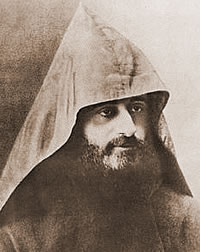The Genocide (part2)
Turkish atrocities
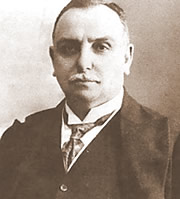 Grigor Zohrab, influential Armenian writer and political figure. Among other prominent Armenian intellectuals of Constantinople, he was arrested and murdered without trial.
Grigor Zohrab, influential Armenian writer and political figure. Among other prominent Armenian intellectuals of Constantinople, he was arrested and murdered without trial.
After what the Turks had termed as “revolution of Van”, the Armenians were declared as “internal enemies” of the Ottoman Empire. In Constantinople, many of the most eminent Armenians, including intellectuals, political and religious leaders were arrested and murdered. Among them were Grikor Zohrab and Vartkes Serengulian, members of the Ottoman Parliament and generally known as friends of Talaat-Pasha.
At the same time, the mass killings took place in Bitlis, Mush and Dyarbekir. The special instructions for the detailed procedure of deportations were sent to all Governors of the vilayets throughout the Ottoman Empire. The Armenians were told they must be deported or relocated, and then marched off to the Syrian deserts between Jerablus, Mosul and Deir el-Zor.
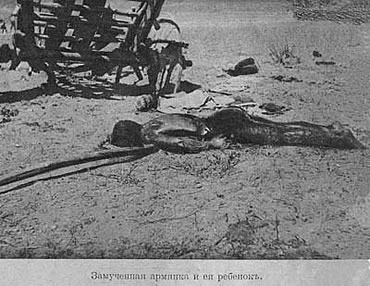 This photo of a murdered Armenian woman and her child, was published in the Russian Iskra newpaper, on October 18, 1915. Source: http://centerar.org
This photo of a murdered Armenian woman and her child, was published in the Russian Iskra newpaper, on October 18, 1915. Source: http://centerar.org
Only a small part of them will reach the final point. Many will of starvation, but most of them will be killed on the march in extremely barbaric fashion. An American missionary testified to see, while traveling from Malatia to Sivas, a countless number of disfigured corpses all along both sides of the road for 9 hours running. Tens of thousands of dead bodies were thrown to the Euphrates River. In Trebizond, thousands of Armenians were sunk out at the sea…
In July 1915, there were virtually no Armenians remaining in Van, Bitlis, Dyarbekir, Sivas, Erzerum and Trebizond. Only a part of the orphan boys were converted to Islam and adopted by the Turkish families. Soon thereafter, Talat-Pasha told the German Ambassador that the Armenian Question was finally solved. The depopulation of the Western Armenia was successfully completed.
Deportations continued
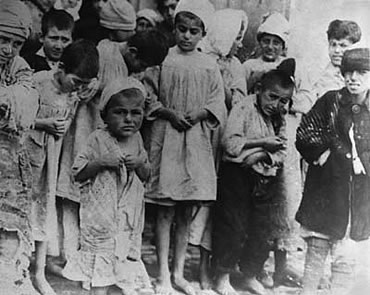 Armenian orphans.Source: http://centerar.org
Armenian orphans.Source: http://centerar.org
In 1916, the deportations and the massacres continued with unremitting cruelty. The numerous instructions went to exterminate the remnants of the Armenian orphans. The survivors were subject to Islamization. But the most of the deportees who later reached the Syrian deserts were murdered or died from hunger or sicknesses.
In October 1916, the German Ambassador Wilhelm Radowitz reported to Berlin that out of the two and a half millions of Armenians in the Ottoman Empire alive were left only 300 000. The rest were killed or deported; some were lucky enough to escape eastward to the Caucasus region. Perhaps the ambassador mentioned “the two and a half millions” in accordance with the falsified results of the census taken in the Ottoman Empire in 1887, under the Sultan Abd al-Hamid. The actual number is unknown, and most likely was significantly played down.
End of Young Turks
 Henry Morgentau, US Ambassador to the Ottoman Empire in 1913-1916. In response to his urgent plea, right after his resignation, the Committee on Armenian Atrocities (later renamed the Near East Relief) was formed, raising over $100 million in aid. In 1918 he published The Ambassador Morgenthau’s Story, in which he described his conversations with Ottoman leaders and his account of the Armenian Genocide.
Henry Morgentau, US Ambassador to the Ottoman Empire in 1913-1916. In response to his urgent plea, right after his resignation, the Committee on Armenian Atrocities (later renamed the Near East Relief) was formed, raising over $100 million in aid. In 1918 he published The Ambassador Morgenthau’s Story, in which he described his conversations with Ottoman leaders and his account of the Armenian Genocide.
The governments of all European countries, and the United States condemned the Genocide of Armenians. Henry Morgenthau, the US Ambassador to the Ottoman Empire, wrote: “…the whole history of the human race contains no such horrible episode as this. The great massacres and persecutions of the past seem almost insignificant when compared to the sufferings of the Armenian race in 1915.”
The Ittihad Cabinet resigned in October 1918. The triumvirs and other leaders of the Young Turks fled the country. They later were convicted by different courts-martial. Enver, Talat, Gemal and Nazim were sentenced to death by default. Kemal Bey, responsible for Yozgat massacres, was publicly hanged. Rashid Bey, governor of Dyarbekir, committed suicide. Other culprits of massacres were sentenced to different terms of imprisonment. Some of them were later released; others fled to join the army of Mustafa Kemal. However, the Genocide of Armenians was never officially recognized and condemned by the Turkish government. Even now, the Turkish authorities continue to deny the fact of the Genocide.
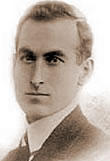 Soghomon Teilirian, who assassinated Talat-Pasha in Berlin, in 1921, became a symbol of Armenian revenge.
Soghomon Teilirian, who assassinated Talat-Pasha in Berlin, in 1921, became a symbol of Armenian revenge.
Talat-Pasha, one of main designers of the Genocide, was assassinated in 1921 in Berlin by Soghomon Tehlirian.
Enver-Pasha also fell from an Armenian in 1922 in a battle in Tajikistan.
Gemal-Pasha was assassinated in 1922 in Tiflis by an Armenian Stephan Tzagikian.
Gemal Azmi, former governor of Trabzon and Beahaddin Shakir, one of the Genocide’s propagandists were both assassinated in 1922 in Berlin.




